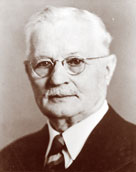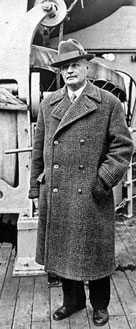|
At Texas A&M University’s spring 2006 commencement
ceremonies, the Association of Former Students presented a posthumous
Distinguished Alumni Award to Frederick E. Giesecke, who founded
Texas’s first formal architectural education program 100
years ago at what is today Texas A&M University.
The program began with the introduction of a brand new curriculum
in architectural engineering, which was developed and taught
by Giesecke.
A wunderkind of the first magnitude, Giesecke, was a product
of the A&M Corps of Cadets. An excellent student and former
captain in the Corps, he joined the A&M faculty after graduating
in 1886 with a B.S. in Mechanical Engineering.
He was only 17 years old!
Within two years, at age 19, he was appointed head of A&M’s
Department of Mechanical Drawing. He completed a Mechanical Engineering
degree at A&M in 1890, and in the ensuing years, while still
on the A&M faculty, he studied architectural drawing at Cornell
University and architectural design at Massachusetts Institute
of Technology — where he earned a degree in architecture
in 1904.
It was upon returning to College Station that Giesecke developed
a curriculum in architectural engineering. He served as head
of the A&M architecture program until 1912 when he took a
job as professor of architecture at the University of Texas.
There, until 1920 he engaged primarily in research as head of
the Division of Engineering’s Bureau of Economic Geology
and Technology.
In 1924, Giesecke earned his fourth degree, a Ph.D. from the
University of Illinois. Then, in 1927, he returned to Texas A&M
as head of the Department of Architecture and the official college
architect. Within a year, he was named head of the Texas Engineering
Experiment Station.
He was, without question, the first Aggie architect.
Through 1939, Giesecke designed and supervised the construction
of many campus buildings that are still standing today, including
the Academic Building, the Chemistry Building, the Williams Building,
Cushing Library and Hart and Walton halls.
He was the first head of the Texas Engineering Experiment Station
and he led the formation and drafted the constitution of the
first Alumni Association, the forerunner of The Association of
Former Students.
Giesecke’s life was characterized by his desire to learn
by study, experimentation and observation. His daily notebook
contained an entry from an experiment he was conducting just
two hours before he died of a heart attack on June 27, 1953.
In 2004, Giesecke was posthumously honored as an Outstanding
Alumnus of the College of Architecture. Following in Frederick
Giesecke’s footsteps, as Aggies and designers who contributed
significantly to Texas architecture, were his son-in-law, Preston
Geren, Sr., Class of 1912, and his grandson, Preston Geren,
Jr., Class of 1945. This year, Preston M. Geren, Jr. established
a lecture series at the college in Giesecke's name.
More information
about the gift that Preston M. Geren, Giesecke's grandson,
gave to the college this year:
Auditorium name honors 'first family' of Texas architecture
| |

Frederick E. Giesecke, founder of Texas's
first formal architectural education program.

Frederick E. Giesecke as a cadet

Frederick E. Giesecke
|

